Counter Sonar measures - A Bathythermograph
by Robert Derencin
Counter Sonar measures
(A bathythermograph)
1. Introduction
Sonar is very important part of anti submarine warfare. The sonar is a device for detecting and locating objects submerged in water by means of the sound waves they reflect or produce.But, for any measure there is counter measure. In WW2 the US Navy submarines were equipped with a bathythermograph. Purpose of this article is to explain how the bathythermograph can be used to make surface ships sonar ineffective. In the article will be explain history and technical data of active sonar. Passive sonar (underwater sound detector) is not matter of the article.
2. Basic hydro acoustic
Sound is mechanical oscillating. Spreading of the sound is possible because of elastic connection between molecules. Molecules in liquids are closer one to another than in the air. Because of that the sound spreads faster in the water than in the air. Speed of the sound in the water is 4.4 times faster than in the air. Exact speed of the sound in the water is 1438 m/s, when temperature of the water is 8 degrees Celsius. Speed and direction of the sound wave spreading depend about temperature, salinity and depth of the water.For example, increasing of the water temperature makes the sound speed faster. Refraction is bending of the sound wave when the sound spreads across different water layers with the different temperature. The refraction can be negative (summer) or positive (winter).
Negative refraction: during the summer temperature of water decreasing by depth of the water. Sound wave is bending towards the sea bottom. If submarine is on smaller depth, near the sea surface, sonar can’t detect the submarine. Range of the sonar is bigger if the submarine is merged on deeper depth.
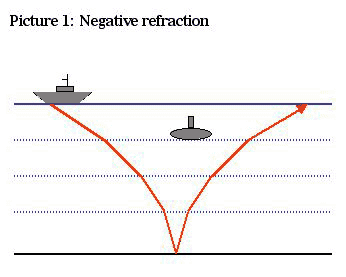
Positive refraction: during the winter temperature of water increasing by depth of the water. Sound wave is bending towards the sea surface. If submarine is merged near the sea surface, sonar can detect the submarine. Positive refraction makes the sonar range bigger.
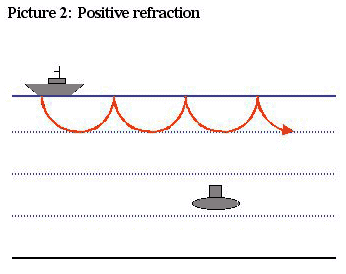
3. Underwater surveillance by means of active sonar
3.1. History
In WW1 active sonar was in experimental phase. It means that the active sonar wasn’t used in fight against submarines. The first active sonar was constructed in 1918, in the Admiralty Experimental Station (UK). On the first testing the sonar found merged submarine on distance of a few hundred metres.
In 1939, Great Britain had 165 destroyers and 54 patrol ships and minesweepers equipped with the active sonar. Before WW2, the United States had 60 destroyers equipped with the active sonar. Germany had many ships and submarines equipped with the sonar. In the German navy, the sonar was known as “S-unit”. In WW2 the sonar was improved in all navies involved in the war. The active sonar generally was fitted on surface ships. Submarines generally were equipped with passive sonar i.e. “Underwater sound detector”.
3.2. Technical description
The first practical sonar units have been constructed between WW1 and WW2. The best working frequency was 20 kHz, pulse power was 50 W. Range was 1000 to 1500 metres (good working conditions) or 500 to 700 metres (bad working conditions). In WW2 there are two types of sonar, projection type and panoramic type.Projection sonar: beam 5 to 15 degrees, frequency 10 to 50 kHz, output pulse power 50 to 200 W, duration of signal 30 to 200 ms. Range was 800 to 4500 metres. In winter range was better than in summer. In WW2 average range of submarine detecting was 1350 metres (from a destroyer). Range of sonar depended about:
-
power of output signal;
working frequency – if frequency is lower range is bigger, but there is problem of direction; shape and size of ultra sound beam – narrow beam makes longer range and better directing than broad beam but with narrow bean it is harder keep contact with the submerged submarine and it is need more time to survey sector around the ship. time of duration of output signal – for longer range survey the sonar needs longer duration of output signal.
Panoramic sonar: The sonar transmits its sound beam in all directions immediately. The sonar’s receiver receives echo of the sound from all directions and shows possible contact on its screen, with direction and range of the contact.
Working frequency: 20 and 25.5 kHz, output power 200 to 800 W, duration of signal 6, 30 or 80 ms. Range was up to 3000 metres. The first successful panoramic sonar in the United States was QHB-1, in 1943.
There was also sonar for detecting depth of submerged submarine. It was additional unit and it works together with standard sonar unit. Working frequency of that additional sonar was from 15 to 100 kHz. Depended about construction, there are: hull mounted sonar and towed sonar.
4. A bathythermograph
A bathythermograph is an instrument for recording the temperature at various depths in the ocean. Area of detecting is from –2.2 to 32.2 degrees of Celsius. The bathythermograph may be fitted on a surface ship or on a submarine. During the measurements the ship’s (or the submarines) speed can be up to 22 knots, normally up to 12 knots.A bathythermograph consists of a thermal and a depth part. Results of the measurements are shown on a bathythermogram. When a submarine is submerged, she cannot use a bathythermograph. Instead of that, she has an apparatus for continuously measuring speed of a sound at all depths of the submarine.
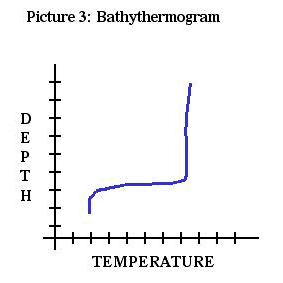
5. How a bathythermograph can be used to make sonar ineffective
When we use a bathythermograph, we actually look for a thermo cline. A thermo cline is a layer of water where the temperature gradient is greater than that of the warmer layer above and the colder layer below. When the temperature gradient is greater, a sound wave rapidly bending towards the sea bottom. The sound wave goes to the sea bottom and “stay there”. The sound wave is useless.
If a submarine is submerged at the layer of thermo cline or immediate below the layer, the submarine will not be “captured” from the wave, and she will stay undetected. Picture number 4 shows situation when the submarine is submerged immediate below the layer of thermo cline, and the surface ship is fitted with the hull mounted sonar.
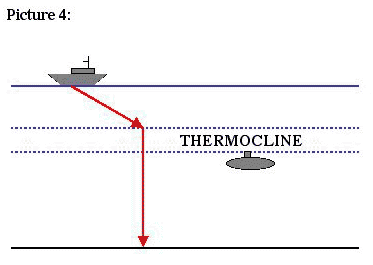
There are usually two layers of a thermo cline in summer. One layer is on about 15 to 20 metres of depth, and another one is about 150 metres of depth. Depth of 15 to 20 metres is important. During the summer, at afternoon, if weather conditions are good, a submarine could not be detected from standard (hull mounted) ship’s sonar. In the same time, the depth is good for observing and torpedo launching. If the surface ship wishes to detect a submarine, the ship has to be fitted with towed sonar. In that case, the sonar must be submerged below the thermo cline. Picture number 5 shows situation when the submarine is submerged below the layer of thermo cline and the surface ship is fitted with towed sonar.
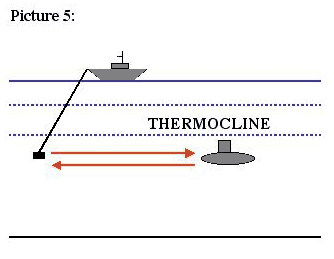
6. Conclusion
Naval persons learn much about navigation, meteorology, maritime law, naval technologies, weapons… But they study oceanography and hydro acoustic, too. In this article I tried to explain why oceanography and hydro acoustic are important part of submarine and counter submarine warfare. A sonar operator can detect submarine easy and precise. On another side, a submarine commander can avoid detection by sonar. But, they have to know all about ocean, because the ocean is their natural environment.
This article was published on 24 Jun 2002.

